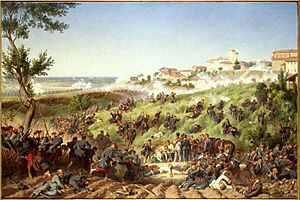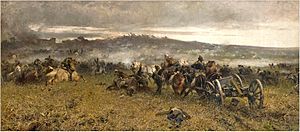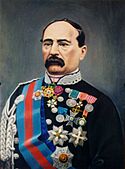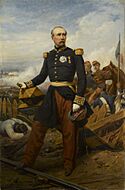Second Italian War of Independence facts for kids
Quick facts for kids Second Italian War of Independence |
|||||||||
|---|---|---|---|---|---|---|---|---|---|
| Part of the wars of Italian unification and the French-Habsburg rivalry | |||||||||
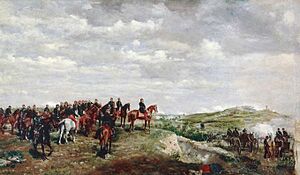 Napoleon III at the Battle of Solferino, by Jean-Louis-Ernest Meissonier, oil on canvas, 1863 |
|||||||||
|
|||||||||
| Belligerents | |||||||||
| Commanders and leaders | |||||||||
| Strength | |||||||||
312 guns 90 guns |
824 guns |
||||||||
| Casualties and losses | |||||||||
1,128 missing 17,054 wounded 2,040 disease related deaths Total: 25,720 casualties 3,572 wounded 1,268 missing Total: unknown |
Total: unknown |
||||||||
The Second Italian War of Independence was a big fight in 1859. It was between the Second French Empire and the Kingdom of Sardinia on one side, and the Austrian Empire on the other. This war was a very important step in creating a united Italy.
Before the war, France and Sardinia made a secret deal. France agreed to help Sardinia kick Austria out of Italy. In return, France would get the areas of Savoy and Nice. They signed a military agreement in January 1859.
Sardinia got its army ready in March 1859. Austria did the same in April. On April 23, Austria told Sardinia to send its soldiers home. Sardinia said no, and the war began on April 26. Austria invaded Sardinia a few days later. France then declared war on Austria on May 3.
French soldiers quickly arrived in Piedmont, stopping the Austrian invasion. The French and Sardinian armies beat the Austrians at the Battle of Magenta on June 4. They pushed the Austrians back to Lombardy. Another big win for France and Sardinia happened at the Battle of Solferino on June 24. This battle ended the war. A peace agreement, called the Armistice of Villafranca, was signed on July 12.
Austria gave Lombardy to France, and France then gave it to Sardinia. Sardinia also took over other parts of central Italy. These included Tuscany, Parma, Modena, and parts of the Papal States. Later, Sardinia gave Savoy and Nice to France, as they had agreed.
Why the War Started
Sardinia Looks for Friends
After losing to Austria in an earlier war, the Kingdom of Sardinia knew it needed help. Its leader, Prime Minister Camillo Benso, Count of Cavour, tried to make friends with other European countries. Sardinia even joined the Crimean War to show it was a strong ally.
At the peace meeting after the Crimean War, Cavour tried to talk about uniting Italy. Britain and France were interested but did not want to upset Austria. Austria controlled a large part of Italy called Lombardy–Venetia.
Napoleon III's Decision
In 1858, an Italian man named Felice Orsini tried to kill Napoleon III, the leader of France. This event made many people feel sorry for Italy. It also made Napoleon III decide to help Sardinia against Austria. He wanted to stop more revolutionary actions in Italy.
So, Napoleon III and Cavour met secretly in July 1858. They signed a secret agreement in January 1859. France would help Sardinia if Austria attacked first. In return, Sardinia would give Nice and Savoy to France. This deal helped Sardinia unite Italy and made Austria weaker.
How the War Began
Cavour knew France would only help if Austria attacked first. So, he made Austria angry by moving Sardinian soldiers close to the border. Sardinia got its army ready on March 9, 1859. Austria did the same on April 9.
On April 23, Austria sent a message to Sardinia. It demanded that Sardinia send its army home. Sardinia refused. So, Austria started the war against Sardinia on April 26. The first French soldiers arrived in Piedmont on April 25. France officially declared war on Austria on May 3.
Armies in the War
French Army Strength
The French army sent to Italy had 170,000 soldiers. They also had 2,000 horsemen and 312 cannons. This was half of the entire French army. Napoleon III himself led the army. He divided it into five main groups, called corps.
Napoleon III went to the battlefields. He believed this would make his soldiers and the French people feel more motivated. It worked well.
Sardinian Army Strength
The Sardinian army had about 70,000 soldiers. They had 4,000 horsemen and 90 cannons. This army was also divided into five groups. Two groups of volunteers, called the Cacciatori delle Alpi and the Cacciatori degli Appennini, also joined. Victor Emmanuel II, the King of Sardinia, led his army.
Austrian Army Strength
The Austrian army was larger. It had 220,000 soldiers, 824 cannons, and 22,000 horsemen. Ferenc Gyulay was their main commander.
Other Support
The United Principalities of Moldavia and Wallachia also helped France and Italy. Their leader, Alexandru Ioan Cuza, received 10,000 rifles from Napoleon III. Napoleon III also sent military experts to help. This made Austria keep 30,000 soldiers in Transylvania. These soldiers could not be used in Italy, which helped France and Sardinia.
The War in Action
Austrian Invasion Slows Down
The French army moved into Piedmont using trains. This was one of the first times trains were used so much in a war. The Austrians hoped to quickly defeat the smaller Sardinian army before the French arrived.
However, the Austrian commander, Count Gyulai, was very careful. He moved his army slowly around the Ticino River. When he finally crossed it to attack, heavy rains began. The Piedmontese flooded the rice fields, which made the Austrian army's march very slow.
Early Battles and French Arrival
The Austrians captured Novara on April 30 and Vercelli on May 2. They then moved towards Turin. But the French and Sardinian armies made their defenses stronger around Casale Monferrato. This forced the Austrians to stop their advance on May 9 and retreat on May 10.
Napoleon III arrived in Italy on May 12 and took command. The first big fight was the Battle of Montebello on May 20. The Austrians fought for nine hours but retreated when Sardinian horsemen arrived. This made the Austrian commander even more cautious.
Key Victories for France and Sardinia
Napoleon III crossed the Ticino River and entered Lombardy. He sent many troops to the north to attack the Austrians from the side. The Austrians planned to defend Milan, but they were defeated at the Battle of Magenta on May 5. This made Gyulai retreat further east. The Austrian Emperor Franz Josef then took over command himself.
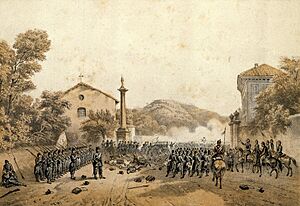
The combined Piedmontese-French army took Milan. They slowly moved east to finish off Austria before Prussia could get involved. During their retreat, the Austrians won a small victory when Karl von Urban defeated Giuseppe Garibaldi at the Battle of Treponti.
The two armies met by accident near Solferino. This led to a confusing series of battles. A French group held off three Austrian groups all day at Medole. This stopped them from joining the main battle at Solferino. After a long day of fighting, the French broke through the Austrian lines. The entire Austrian army then retreated back to their strong forts.
Meanwhile, in northern Lombardy, Italian volunteers led by Giuseppe Garibaldi won battles against the Austrians at Varese and Como. The Piedmontese-French navy also landed soldiers and took islands in Dalmatia.
The End of the War
Peace Agreement at Villafranca
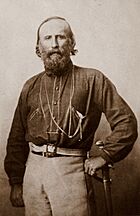
After the Battle of Solferino, a ceasefire was agreed on July 8. The two emperors, Napoleon III and Franz Josef, met on July 11. The peace agreement, called the Peace of Villafranca, was signed the next day.
Napoleon III signed this agreement for several reasons. The Austrians had retreated to very strong forts that would be hard to capture. Also, his absence from France was causing problems at home. He was also being criticized in France for his actions in Italy. He did not want Sardinia to become too powerful. He also worried that German states might join the war.
Most of Lombardy, including its capital Milan, was given from Austria to France. France then immediately gave it to Sardinia. The agreement also said that the rulers of central Italy, who had been removed by revolutions, should be put back in power.
Aftermath and Unification
This agreement made by Napoleon, without telling his Sardinian allies, made Sardinia very angry. Cavour, the Sardinian Prime Minister, resigned in protest. However, the terms of the Villafranca agreement never fully happened.
The central Italian states were taken over by Sardinia. Sardinia refused to bring back the old rulers, and France did not force them to. Austria was frustrated that France did not follow the agreement. Austria's power in Europe was now much weaker, especially in Italy.
The next year, with France and Britain's approval, the central Italian states joined the Kingdom of Sardinia. These included Parma, Modena, Tuscany, and parts of the Papal States. France then received Savoy and Nice as promised.
This move was strongly opposed by Giuseppe Garibaldi, who was from Nice. It led to Garibaldi's famous expedition to Sicily. This expedition helped complete the first steps of uniting Italy. Many people from Nice who felt Italian moved to Italy after Nice became part of France.
During the war, Prussia also got its army ready. But it never joined the fighting. The problems Prussia saw in its army during this time led to big military changes. These changes helped Prussia win quickly against Austria in 1866 and France in 1870-71. These victories led to a united Germany under Prussia's leadership.


